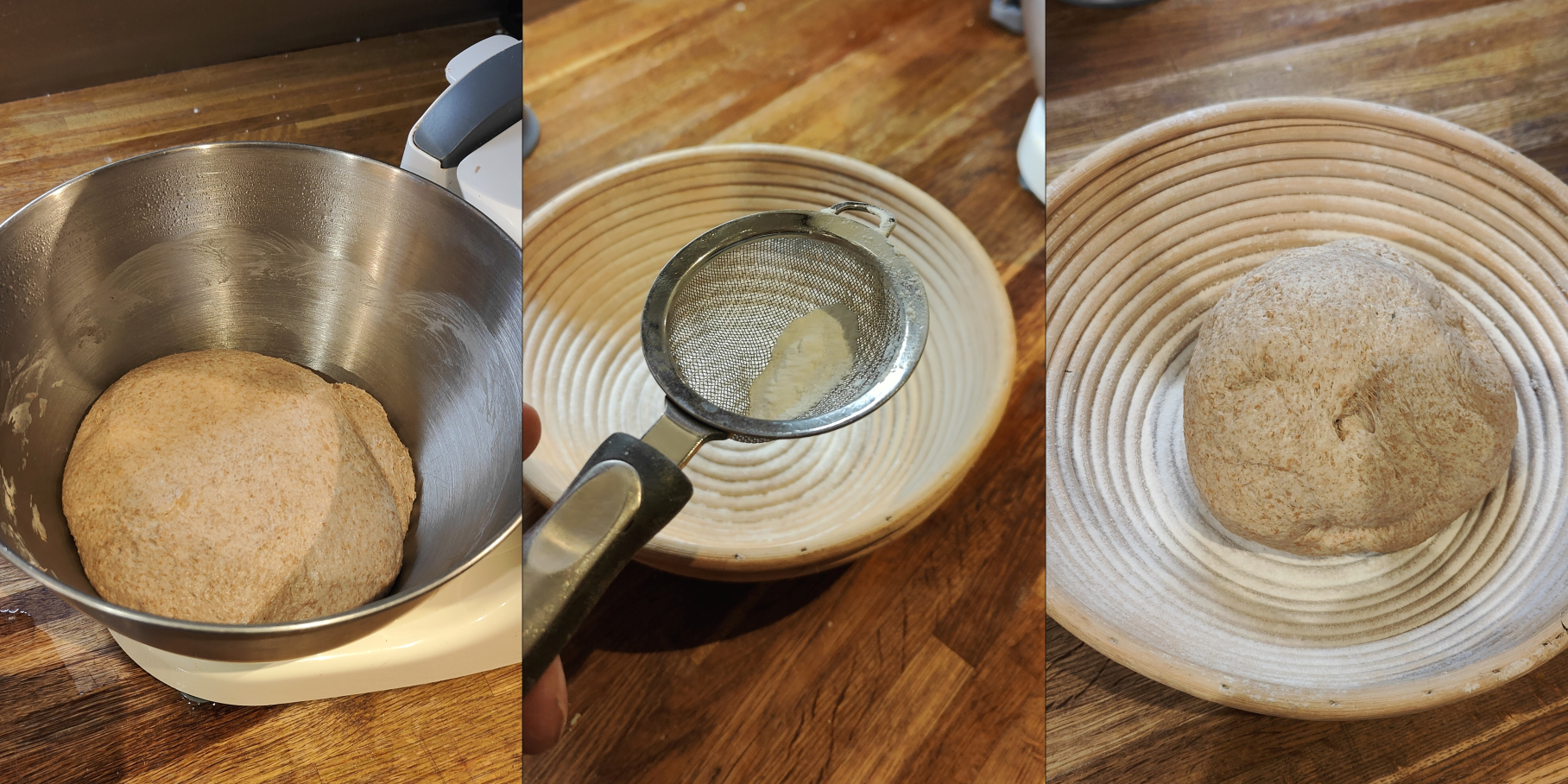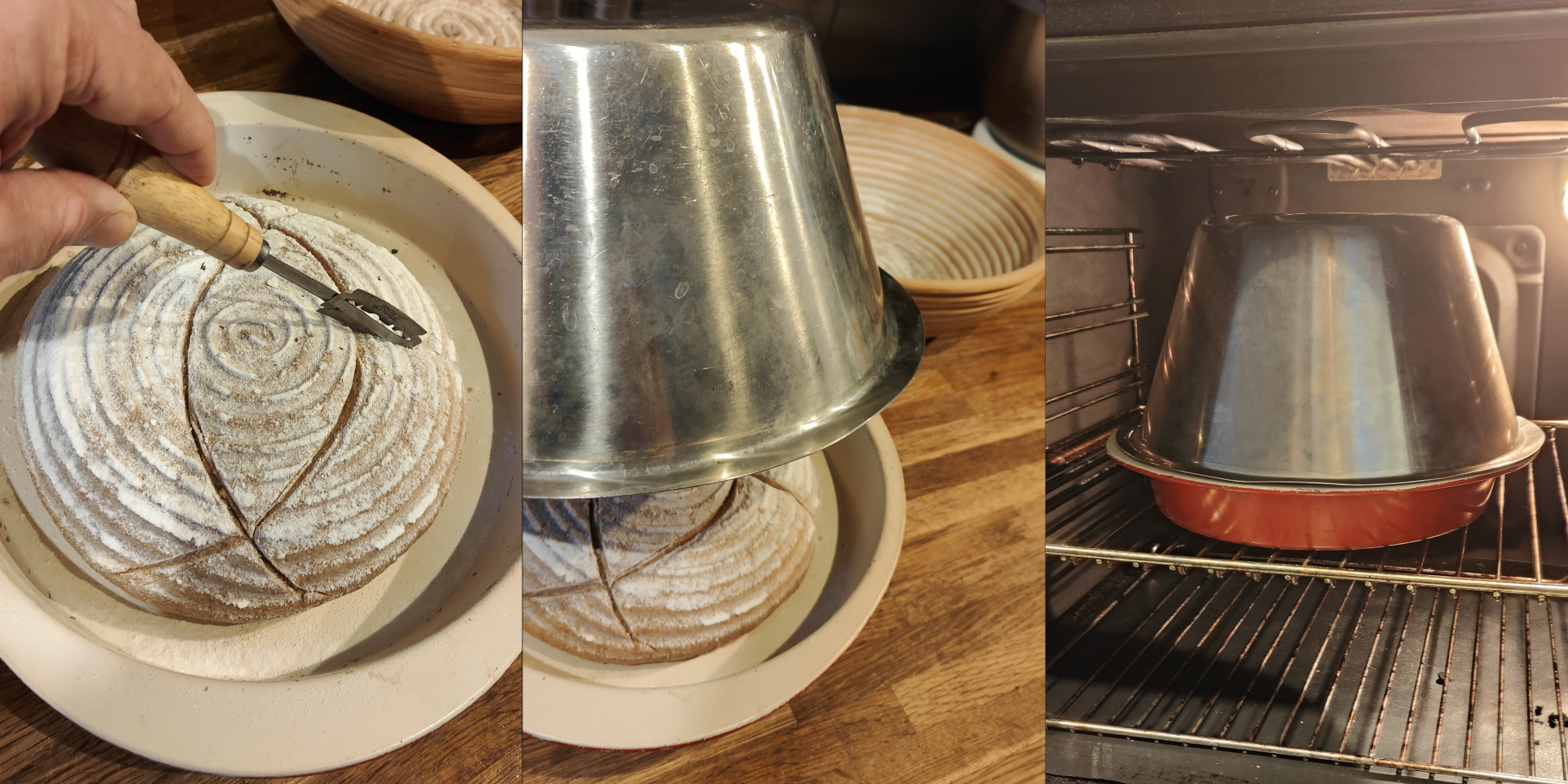Ingredients
- 100g starter
- 100g strong white flour
- 300ml water
- 400g wholemeal bread flour
- 1 tsp salt
- 1 tbsp rice flour
A wholemeal loaf with the minimum of process and no manual kneading
Like everyone else I started baking with sourdough in lockdown. I stopped when my starter died while we were on holiday in Crete. It didn’t come with us, I just left it out in a hot summer kitchen for two weeks and it asphyxiated like a dog in a hot car. Now I keep a batch of sourdough starter frozen in the oven in case of similar mishaps. I’ve never tried it but my mum reckons it will spring to life when defrosted, as if nothing had happened.
This is one of those recipes that seems more complicated when you write it down than it is when you do it. Especially if you do it regularly, when it becomes second nature. If it doesn’t work first time there’s a reason for it, so just try something slightly different next time.
The fermenting of the dough and the initial creation of the levain take a long and unpredictable time. The worst case scenario is that it’s ready for the next step at 4 o’clock in the morning and you’re sound asleep. By the time you wake up it’s over-proved and useless. Don’t panic. You can stop the clock by putting it in the fridge. In the morning just take it out and leave it to come up to room temperature, then the fermentation will start again.
The loaf in this recipe isn’t my best work. I’m sharing it in a spirit of have-a-go and don’t worry too much about the result. Sourdough bread always tastes great even if it hasn’t quite worked. This loaf disappeared very quickly.
Prepare the levain

- Mix 100g of fairly active starter with 100g of strong white flour and 100ml of room-temperature water
- Leave to ferment until it's frothy and ready for battle (about 6 hours depending on temperature and lots of other things)
- This is your levain
Mix the ingredients

- Add the levain, wholemeal bread flour and salt to the mixer bowl. Maybe put the salt in the bowl first to stop it coming into contact with the levain before it has been diluted by the flour.
- Using the dough hook mix to a firm dough by adding more water a little at a time (around 200ml)
- You're trying to make a dough that is just soft enough to incorporate all the flour but firm enough for the dough hook to knead.
- If you add too much water the dough hook will either spin the whole dough ball around uselessly or spin itself round in a bowl of porridgey dough. If either of these things happens, don't panic. You can just add more flour to bring it back to the desired consistency. You'll just get a bigger loaf! It may take a little longer to rise.
- Once all the flour is incorporated, stop mixing. The flour needs 20 mins or so to autolyse. This just means letting the dough rest and allow the water to hydrate the flour.
Knead the dough

- On a slow speed, use the mixer with the dough hook attachment to knead the dough for 5 minutes.
- It should be noticeably stretchier and smoother.
- Leave to rise under a damp cloth until it has doubled in size.
Transfer the dough to a banneton

- Using a sieve, flour a banneton with rice flour.
- Knock back the risen dough (knead it gently for a couple of minutes).
- Place in the banneton and leave it to rise again under a damp cloth.
- Heat the oven to 230°C
Bake!

- We'll be baking the loaf in a dutch oven. I don't have a purpose-made one so I use a flan dish with a metal mixing bowl on top.
- Turn out the dough into the bottom of the dutch oven.
- Slice it with a razor blade or lame to give some opportunities to rise in the oven.
- Put the lid on your dutch oven and pop it in the oven for 35 minutes.
- Remove the lid and give it another 10-15 minutes to brown the crust. Remove from the oven when it's the colour you hoped it would be and smells like your house is on the market.
Eat

- Allow to cool for a few minutes.
- Slice, cover with thick butter and eat.
- Preparation time
- 480 minsPT480M
- Cooking time
- 45 minsPT45M
A wholemeal loaf with the minimum of process and no manual kneading
1125
51
Breadmaking
International"
sourdough, baking, recipe, loaf, wholemeal"
1